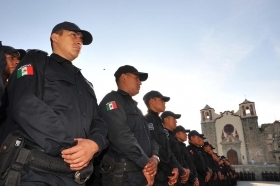Some analysts point to higher salaries as a way to reduce corruption among Mexico’s police, but such an approach is only one part of the reforms needed to make law enforcement in the country more honest.
This issue of police pay was pushed to the top of the agenda by a government report revealing that the police in Tamaulipas, a violence-addled border state where corruption is rife, have the lowest salaries in the country. According to Animal Politico, the average state police officer in Tamaulipas makes just 3,618 pesos a month, which at present exchange rates is a little more than $250.
The nationwide average for a state police officer’s monthly salary is just under 10,000 pesos, or roughly $700, while federal police officers earn an average of 12,000 pesos a month. In Aguascalientes, a small central state not known as a hotbed of organized crime activity, state police officers earn five times more than their counterparts in Tamaulipas.
Whatever the justification, the Tamaulipas wage is truly a pittance. Teachers commonly earn three times that amount, and indeed a successful streetside burrito vendor would make significantly more. Furthermore, the price levels in the border states are generally higher than in the country as a whole, and most of Tamaulipas is in the most costly bracket according to the government’s minimum wage scale, which can be taken as a proxy for the cost of living.
The government’s measures put an officer in the Tamaulipas state police squarely above the poverty line, but designations from other observers, such as the consulting firm De la Riva Group, which in a recent report used a household income of 13,500 pesos monthly as the bottom limit for the middle class, place police officers in the state as mired in poverty. Regardless of your preferred poverty line, a salary of less than 4,000 pesos is clearly not enough to pay for the trappings of a middle-class existence — a three-bedroom house, reasonable car, food for a family of four, et cetera.
Certainly, a meager existence could encourage collusion with wealthy organized crime groups. A recent study from the Senate’s Public Security Committee estimated that low-ranking state and municipal officers can earn up to 7,000 pesos per month by colluding with criminal gangs, so an underpaid officer could double or triple his salary by simply agreeing to look the other way.
However, though Tamaulipas has poorly paid police and lots of violence, while Aguascalientes has the opposite dynamic, the relationship between state police salaries and insecurity is not so clear cut. A look at other areas of the country confounds any such easy explanation; Quintana Roo, a Caribbean state where the levels of violence are admirably low, follows Tamaulipas as the state with the poorest paid police.
At the other end of the list, just beneath Aguascalientes, is Baja California, which has long been among the most violent, corruption-ridden states in Mexico. (It’s not entirely clear if the government report refers to Baja California Norte, the much safer state of Baja California Sur, or an aggregation of both states, but media reports suggest that the figure includes police from Baja California Norte.) Zacatecas, which has suffered a recent surge in the violence associated with organized crime, is also among the top four.
Furthermore, it’s not clear that higher salaries will be a determining factor in cleaning up the police. A pair of recent studies looking at police corruption in Mexico, the first by John Bailey and Matthew Taylor, the second by Daniel Sabet, conclude that salary is just one of the variables that determines whether an officer decides to actively work with criminal gangs, to merely tolerate them, or to confront them.
The other factors, which can weigh just as heavily, include the likelihood of being caught and the severity of the resulting penalty; the moral cost and the degree of personal commitment to the job; and the probability of suffering physical attacks, both in cases of agreeing or refusing to work with the gangs.
The salary can, of course, feed into other factors as well; a poorly paid police force is not likely to have a high level of morale and esprit de corps, which makes offices less likely to resist entreaties from criminals. This leads to a general climate of corruption, which makes more likely that an honest police officer would face pressure from his colleagues for turning down offers of illicit cash, and less likely that offending officers would be nabbed for wrongdoing.
Viewed this way, police corruption becomes a self-perpetuating feedback loop, and if the authorities tinker with only one of the variables, whether by raising salaries or recruiting better qualified officers, the corrupting dynamic will likely remain intact. An effective plan to reduce corruption needs to address all of the factors more or less simultaneously. This would involved (among other measures) more robust internal affairs bureaus and vetting tests for officers, protection for threatened police, and, yes, higher salaries to improve institutional morale and reduce the appeal of illicit earnings.
A successful effort can’t be carried out overnight. In many regions, years or even decades of institutional inertia push the average officer toward collusion with or tolerance of the gangs he is meant to combat. Tilting the balance toward police honesty will have to be a gradual process. It will cost a great deal of money, but this investment can’t be spent only on higher salaries.

